Alfa Romeo 166 2006 Owner handbook (in English)
Manufacturer: ALFA ROMEO, Model Year: 2006, Model line: 166, Model: Alfa Romeo 166 2006Pages: 272, PDF Size: 4.17 MB
Page 111 of 272
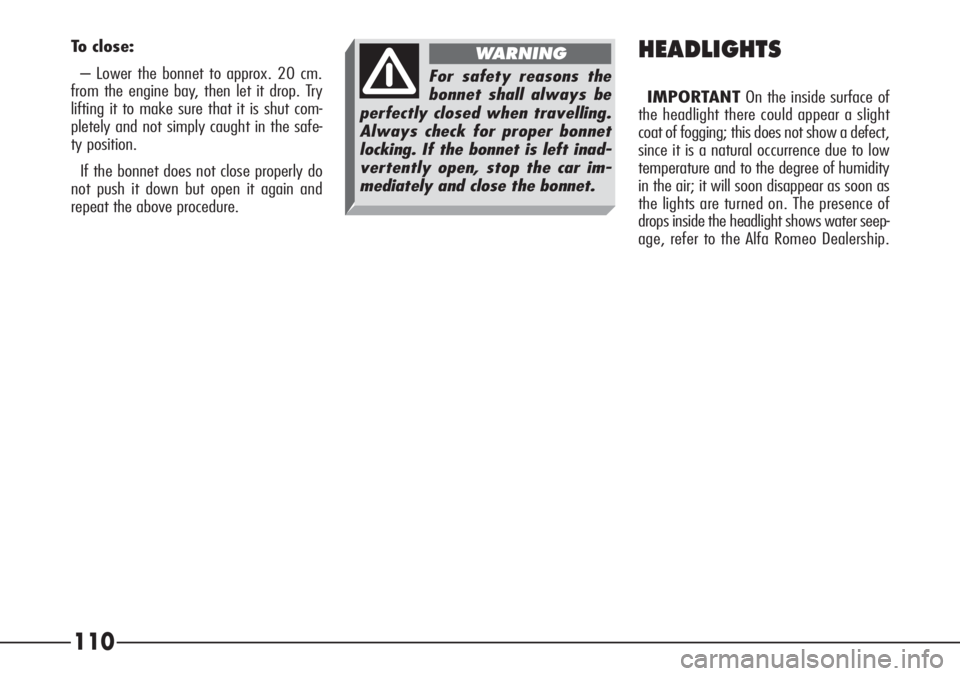
110
To close:
– Lower the bonnet to approx. 20 cm.
from the engine bay, then let it drop. Try
lifting it to make sure that it is shut com-
pletely and not simply caught in the safe-
ty position.
If the bonnet does not close properly do
not push it down but open it again and
repeat the above procedure.HEADLIGHTS
IMPORTANTOn the inside surface of
the headlight there could appear a slight
coat of fogging; this does not show a defect,
since it is a natural occurrence due to low
temperature and to the degree of humidity
in the air; it will soon disappear as soon as
the lights are turned on. The presence of
drops inside the headlight shows water seep-
age, refer to the Alfa Romeo Dealership.
For safety reasons the
bonnet shall always be
perfectly closed when travelling.
Always check for proper bonnet
locking. If the bonnet is left inad-
vertently open, stop the car im-
mediately and close the bonnet.
WARNING
Page 112 of 272
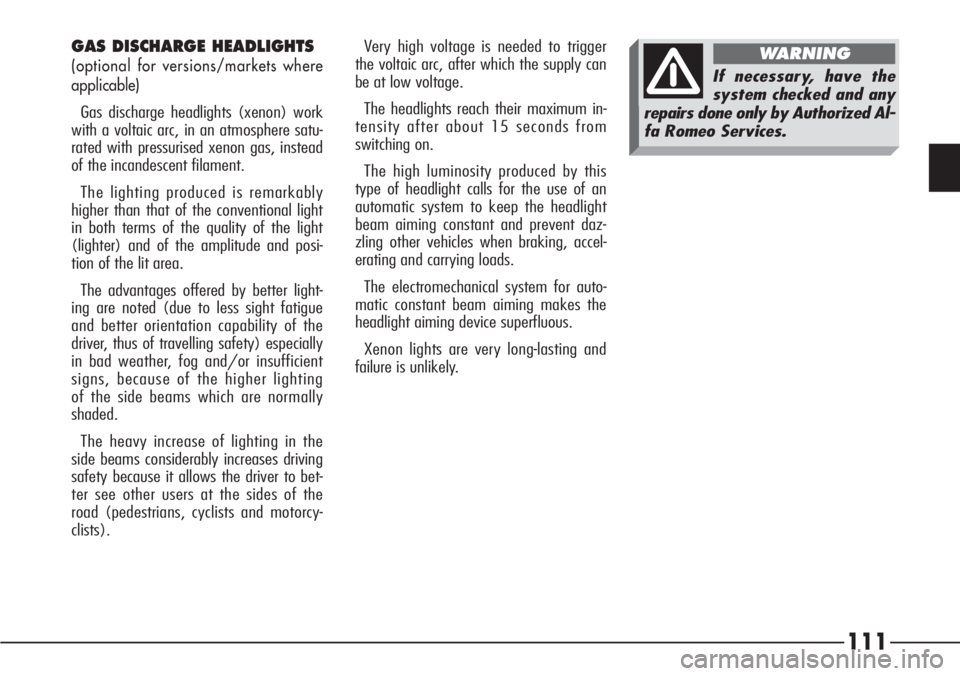
111
GAS DISCHARGE HEADLIGHTS
(optional for versions/markets where
applicable)
Gas discharge headlights (xenon) work
with a voltaic arc, in an atmosphere satu-
rated with pressurised xenon gas, instead
of the incandescent filament.
The lighting produced is remarkably
higher than that of the conventional light
in both terms of the quality of the light
(lighter) and of the amplitude and posi-
tion of the lit area.
The advantages offered by better light-
ing are noted (due to less sight fatigue
and better orientation capability of the
driver, thus of travelling safety) especially
in bad weather, fog and/or insufficient
signs, because of the higher lighting
of the side beams which are normally
shaded.
The heavy increase of lighting in the
side beams considerably increases driving
safety because it allows the driver to bet-
ter see other users at the sides of the
road (pedestrians, cyclists and motorcy-
clists).Very high voltage is needed to trigger
the voltaic arc, after which the supply can
be at low voltage.
The headlights reach their maximum in-
tensity after about 15 seconds from
switching on.
The high luminosity produced by this
type of headlight calls for the use of an
automatic system to keep the headlight
beam aiming constant and prevent daz-
zling other vehicles when braking, accel-
erating and carrying loads.
The electromechanical system for auto-
matic constant beam aiming makes the
headlight aiming device superfluous.
Xenon lights are very long-lasting and
failure is unlikely.
If necessary, have the
system checked and any
repairs done only by Authorized Al-
fa Romeo Services.
WARNING
Page 113 of 272
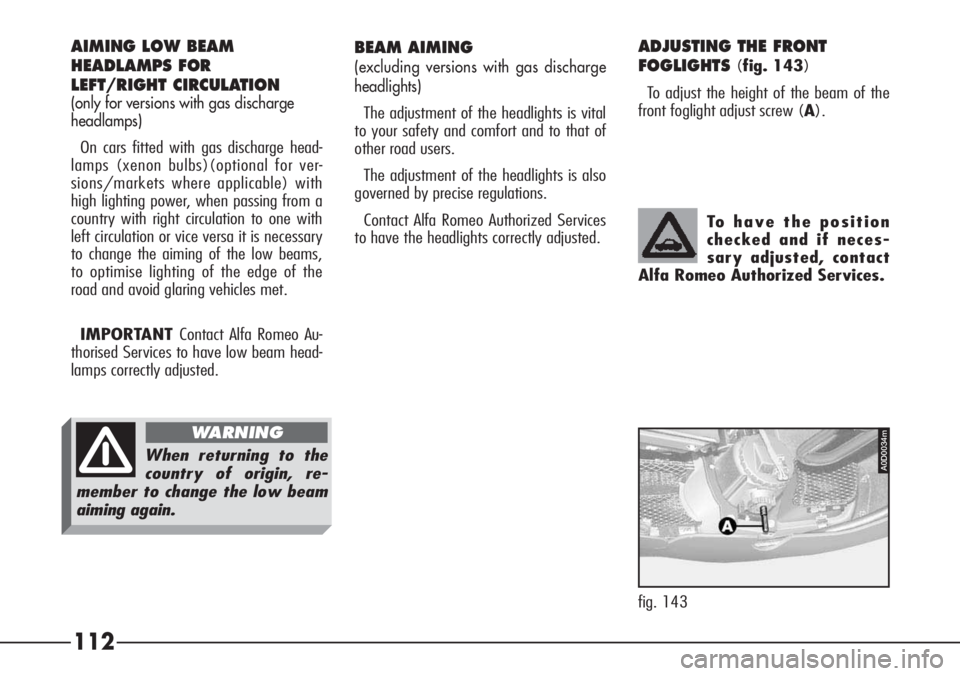
112
AIMING LOW BEAM
HEADLAMPS FOR
LEFT/RIGHT CIRCULATION
(only for versions with gas discharge
headlamps)
On cars fitted with gas discharge head-
lamps (xenon bulbs)(optional for ver-
sions/markets where applicable) with
high lighting power, when passing from a
country with right circulation to one with
left circulation or vice versa it is necessary
to change the aiming of the low beams,
to optimise lighting of the edge of the
road and avoid glaring vehicles met.
IMPORTANT Contact Alfa Romeo Au-
thorised Services to have low beam head-
lamps correctly adjusted.
BEAM AIMING
(excluding versions with gas discharge
headlights)
The adjustment of the headlights is vital
to your safety and comfort and to that of
other road users.
The adjustment of the headlights is also
governed by precise regulations.
Contact Alfa Romeo Authorized Services
to have the headlights correctly adjusted.
When returning to the
country of origin, re-
member to change the low beam
aiming again.
WARNING
To have the position
checked and if neces-
sary adjusted, contact
Alfa Romeo Authorized Services.
ADJUSTING THE FRONT
FOGLIGHTS
(fig. 143)
To adjust the height of the beam of the
front foglight adjust screw (A).
fig. 143
A0D0034m
Page 114 of 272

113
EOBD SYSTEM
(optional for versions/
markets where applicable
)
The EOBD system (European On Board
Diagnosis) allows continuous diagnosis of
the components of the car correlated with
emissions.
This system continuously monitors the
components of the vehicle related to e-
missions; it also indicates, when the
Uwarning light comes on on the instrument
panel, that the components in question
are in poor condition.
IMPORTANTAfter the problem has
been resolved, to completely check the
system, the Alfa Romeo Authorized Ser-
vice Station must carry out tests on a test
bench and, if necessary, road tests that
could be long.If, when the ignition key
is turned to MAR, the
Uwarning light does
not come on or if, when driving, it
lights up and emits a fixed light
or a flashing one, contact an Alfa
Romeo Authorized Service Station
as soon as possible. Warning
light
Uoperation can be checked
by means of special equipment
by traffic agents. Always comply
with the traffic regulations in
force in the country where you
are travelling.
The objective is the following:
– to keep under control the efficiency of
the system;
– to warn when a fault causes emission
levels to increase;
– to indicate the need to replace the
deteriorated components.
The system also has a diagnostic con-
nector that can be interfaced with appro-
priate tools, which makes it possible to
read the error codes stored in the control
unit, together with a series of specific pa-
rameters for engine operation and diag-
nosis. This check can also be carried out
by the traffic police.
Page 115 of 272

114 ABS
The car is fitted with an ABS system
which prevents wheel lock when braking,
better exploits wheel grip and keeps the
vehicle controllable within the limits of
the available grip also during emergency
braking.
The driver can feel that the ABS is oper-
ational by a light pulsing of the brake
pedal, accompanied by noise.
This should not be interpreted as malfunc-
tioning of the brakes, but it is the signal to
the driver that the ABS system is working:
it is the warning that the car is travelling at
the limit of grip and that it is therefore nec-
essary to adapt the speed to the type of
road on which you are travelling.
The ABS system is an additional part of
the basic braking system; in the event of
a fault it is disabled, leaving the braking
system in the same conditions as a car
without ABS.In the event of a failure, though being
unable to rely on the antilock effect,
there is absolutely no adverse effect on
vehicle braking performance in terms of
braking capacity.
If you have never used a car with ABS
before, you are advised to learn how to
use it with a few preliminary trials on a
slippery surface, naturally under safety
conditions and fully adhering to the High-
way Code of the country concerned. You
are also advised to carefully read the fol-
lowing information.
The advantage of the ABS compared
with the conventional system is that it
makes it possible to maintain maximum
vehicle handling performance also in the
case of hard braking under grip limit con-
ditions, avoiding wheel lock.
Do not however expect the braking dis-
tance always to be reduced with the ABS
system: for example, on soft surfaces
such as gravel or fresh snow on slippery
surfaces, the distance might increase.In order to be able to exploit as far as
possible the possibility of the antilock
system in the case of need, it is wise to
follow a few pieces of advice.
The ABS exploits the
available grip in full, but
it cannot increase it; therefore cau-
tion is required on slippery surfac-
es, without running un-necessary
risks.
WARNING
Page 116 of 272
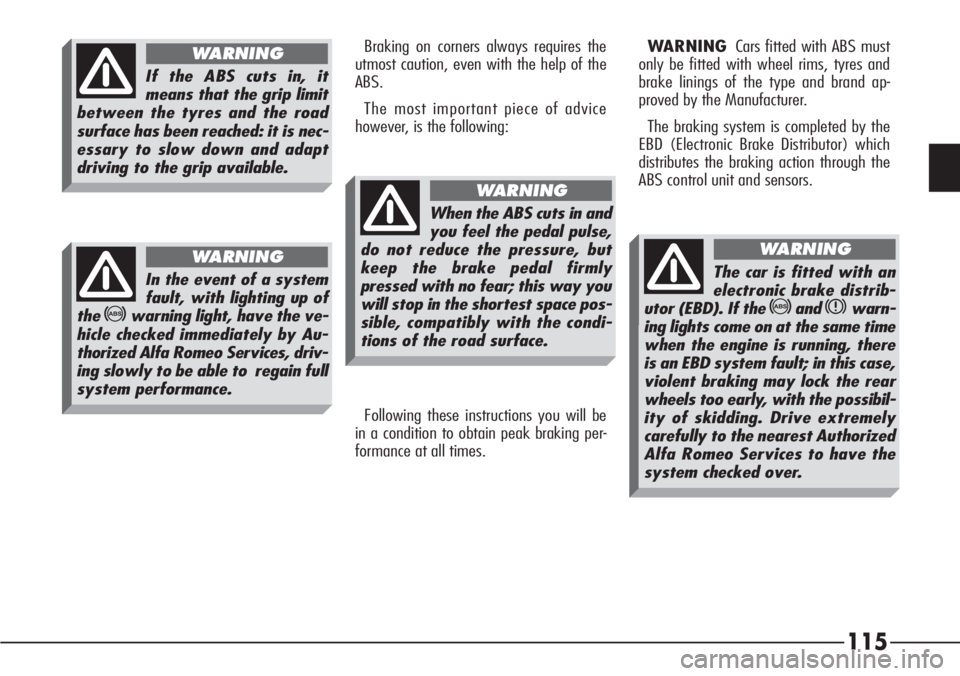
115
Braking on corners always requires the
utmost caution, even with the help of the
ABS.
The most important piece of advice
however, is the following:WARNINGCars fitted with ABS must
only be fitted with wheel rims, tyres and
brake linings of the type and brand ap-
proved by the Manufacturer.
The braking system is completed by the
EBD (Electronic Brake Distributor) which
distributes the braking action through the
ABS control unit and sensors.
Following these instructions you will be
in a condition to obtain peak braking per-
formance at all times.
If the ABS cuts in, it
means that the grip limit
between the tyres and the road
surface has been reached: it is nec-
essary to slow down and adapt
driving to the grip available.
WARNING
In the event of a system
fault, with lighting up of
the
>warning light, have the ve-
hicle checked immediately by Au-
thorized Alfa Romeo Services, driv-
ing slowly to be able to regain full
system performance.
WARNING
When the ABS cuts in and
you feel the pedal pulse,
do not reduce the pressure, but
keep the brake pedal firmly
pressed with no fear; this way you
will stop in the shortest space pos-
sible, compatibly with the condi-
tions of the road surface.
WARNING
The car is fitted with an
electronic brake distrib-
utor (EBD). If the
>andxwarn-
ing lights come on at the same time
when the engine is running, there
is an EBD system fault; in this case,
violent braking may lock the rear
wheels too early, with the possibil-
ity of skidding. Drive extremely
carefully to the nearest Authorized
Alfa Romeo Services to have the
system checked over.
WARNING
Page 117 of 272
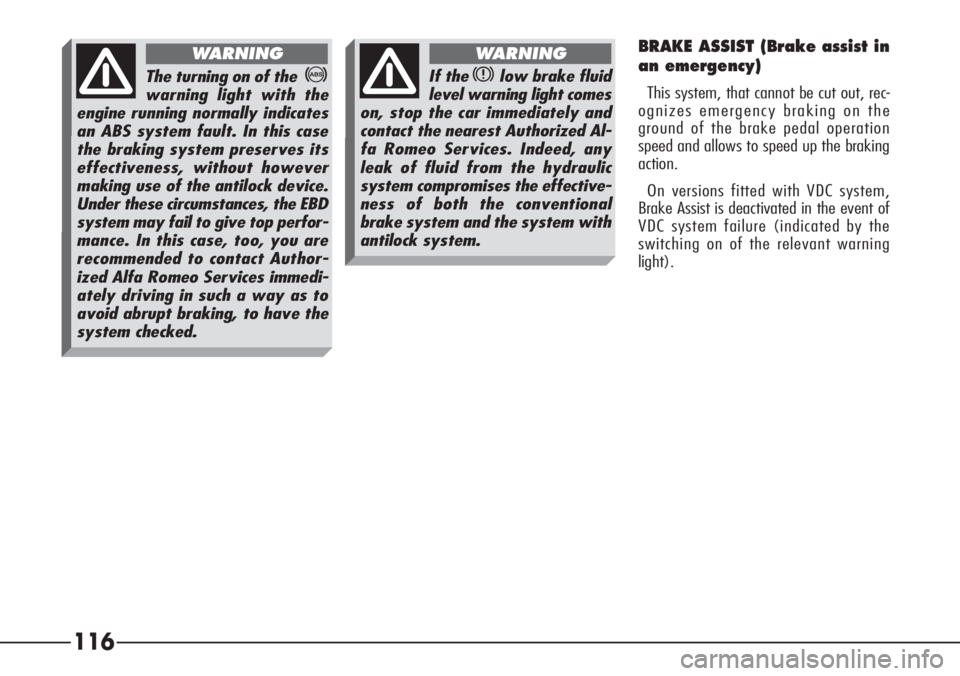
116
BRAKE ASSIST (Brake assist in
an emergency)
This system, that cannot be cut out, rec-
ognizes emergency braking on the
ground of the brake pedal operation
speed and allows to speed up the braking
action.
On versions fitted with VDC system,
Brake Assist is deactivated in the event of
VDC system failure (indicated by the
switching on of the relevant warning
light).
The turning on of the>
warning light with the
engine running normally indicates
an ABS system fault. In this case
the braking system preserves its
effectiveness, without however
making use of the antilock device.
Under these circumstances, the EBD
system may fail to give top perfor-
mance. In this case, too, you are
recommended to contact Author-
ized Alfa Romeo Services immedi-
ately driving in such a way as to
avoid abrupt braking, to have the
system checked.
WARNING
If the xlow brake fluid
level warning light comes
on, stop the car immediately and
contact the nearest Authorized Al-
fa Romeo Services. Indeed, any
leak of fluid from the hydraulic
system compromises the effective-
ness of both the conventional
brake system and the system with
antilock system.
WARNING
Page 118 of 272
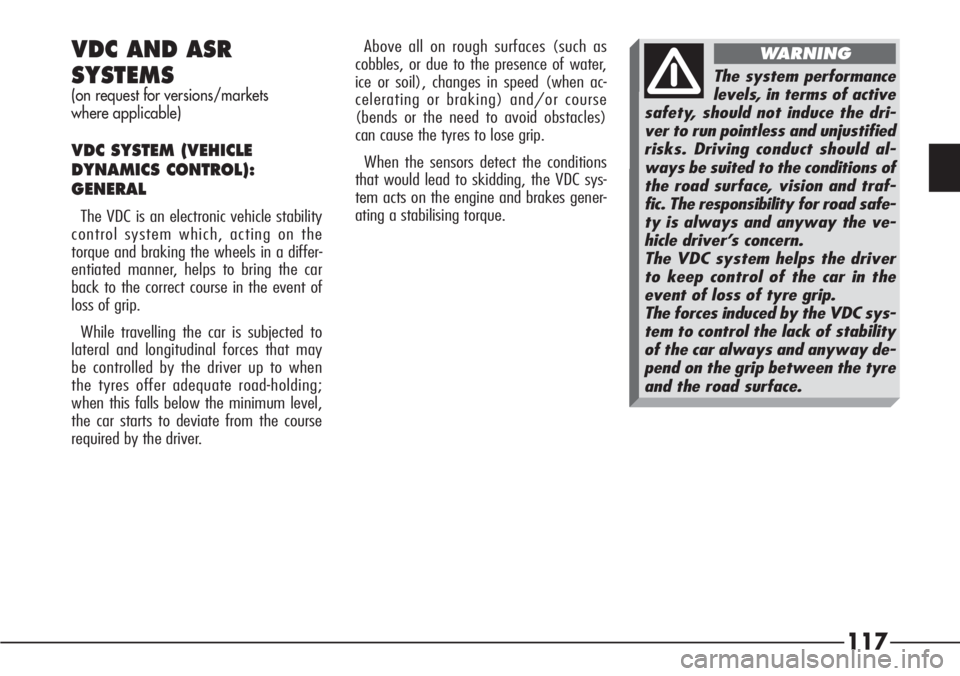
117
VDC AND ASR
SYSTEMS
(on request for versions/markets
where applicable)
VDC SYSTEM (VEHICLE
DYNAMICS CONTROL):
GENERAL
The VDC is an electronic vehicle stability
control system which, acting on the
torque and braking the wheels in a differ-
entiated manner, helps to bring the car
back to the correct course in the event of
loss of grip.
While travelling the car is subjected to
lateral and longitudinal forces that may
be controlled by the driver up to when
the tyres offer adequate road-holding;
when this falls below the minimum level,
the car starts to deviate from the course
required by the driver.Above all on rough surfaces (such as
cobbles, or due to the presence of water,
ice or soil), changes in speed (when ac-
celerating or braking) and/or course
(bends or the need to avoid obstacles)
can cause the tyres to lose grip.
When the sensors detect the conditions
that would lead to skidding, the VDC sys-
tem acts on the engine and brakes gener-
ating a stabilising torque.
The system performance
levels, in terms of active
safety, should not induce the dri-
ver to run pointless and unjustified
risks. Driving conduct should al-
ways be suited to the conditions of
the road surface, vision and traf-
fic. The responsibility for road safe-
ty is always and anyway the ve-
hicle driver’s concern.
The VDC system helps the driver
to keep control of the car in the
event of loss of tyre grip.
The forces induced by the VDC sys-
tem to control the lack of stability
of the car always and anyway de-
pend on the grip between the tyre
and the road surface.
WARNING
Page 119 of 272
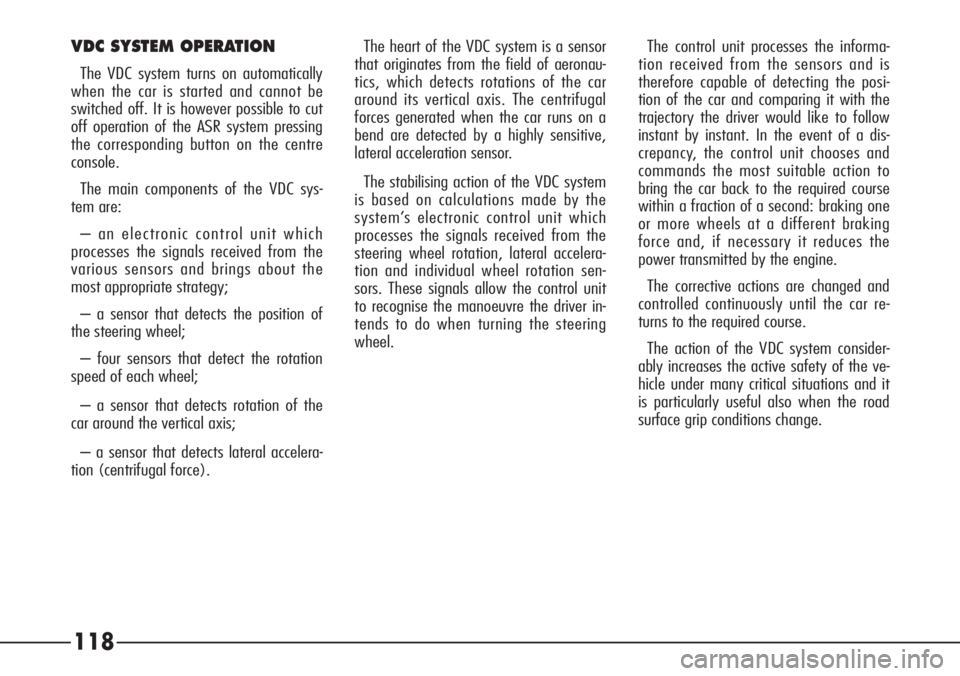
The heart of the VDC system is a sensor
that originates from the field of aeronau-
tics, which detects rotations of the car
around its vertical axis. The centrifugal
forces generated when the car runs on a
bend are detected by a highly sensitive,
lateral acceleration sensor.
The stabilising action of the VDC system
is based on calculations made by the
system’s electronic control unit which
processes the signals received from the
steering wheel rotation, lateral accelera-
tion and individual wheel rotation sen-
sors. These signals allow the control unit
to recognise the manoeuvre the driver in-
tends to do when turning the steering
wheel.
118
VDC SYSTEM OPERATION
The VDC system turns on automatically
when the car is started and cannot be
switched off. It is however possible to cut
off operation of the ASR system pressing
the corresponding button on the centre
console.
The main components of the VDC sys-
tem are:
– an electronic control unit which
processes the signals received from the
various sensors and brings about the
most appropriate strategy;
– a sensor that detects the position of
the steering wheel;
– four sensors that detect the rotation
speed of each wheel;
– a sensor that detects rotation of the
car around the vertical axis;
– a sensor that detects lateral accelera-
tion (centrifugal force).The control unit processes the informa-
tion received from the sensors and is
therefore capable of detecting the posi-
tion of the car and comparing it with the
trajectory the driver would like to follow
instant by instant. In the event of a dis-
crepancy, the control unit chooses and
commands the most suitable action to
bring the car back to the required course
within a fraction of a second: braking one
or more wheels at a different braking
force and, if necessary it reduces the
power transmitted by the engine.
The corrective actions are changed and
controlled continuously until the car re-
turns to the required course.
The action of the VDC system consider-
ably increases the active safety of the ve-
hicle under many critical situations and it
is particularly useful also when the road
surface grip conditions change.
Page 120 of 272

119
The action of the ASR system is particu-
larly helpful under the following condi-
tions:
– Skidding of the inner wheel on a
bend, due to the effect of the dynamic
changes of the load or over-accelerating.
– Excessive power transmitted to the
wheels, also in relation to the conditions
of the road surface.
– Acceleration on slippery, snowy or icy
surfaces.
– In the case of loss of grip on a wet
surface (aquaplaning).ASR FUNCTION (ANTISLIP
REGULATION): GENERAL
The ASR system integrates the VDC sys-
tem controlling the vehicle drive and com-
ing into operation automatically each
time one or both driving wheels skid.
Two different control systems are acti-
vated, depending on the skidding condi-
tions:
– If skidding concerns both driving
wheels, because it is caused by the exces-
sive power transmitted, the ASR system
cuts in reducing the power transmitted by
the engine.
– If skidding concerns only one driving
wheel, the ASR system cuts in automati-
cally braking the skidding wheel, with an
effect similar to that of a self-locking dif-
ferential.
For the VDC, ASR and
ABS systems to work
correctly, the tyres must be of the
same brand and type on all
wheels, in perfect conditions and
above all of the specified type,
brand and size.
WARNING